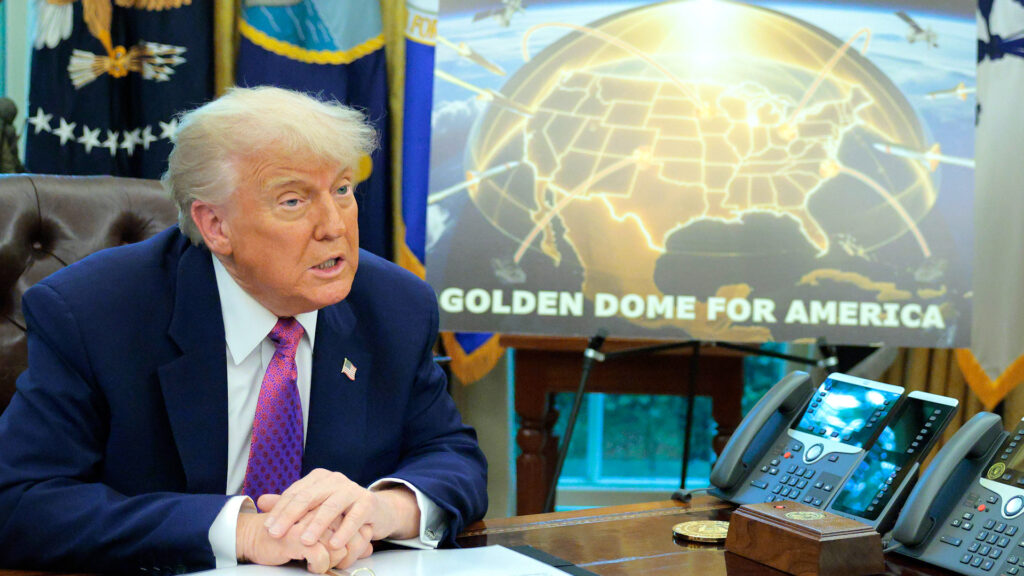President Donald Trump formally introduced a new $175 billion missile defense initiative on Tuesday, May 20, which the administration said is aimed at shielding the United States from long-range threats. The plan, a new missile defense system known as the “Golden Dome,” envisions a layered defense system integrating satellites, sensors and interceptor missiles across the country.
China quickly condemned the plan and warned it could destabilize international security and accelerate an arms race.
“The United States, in pursuing a ‘U.S.-first’ policy, is obsessed with seeking absolute security for itself,” Chinese foreign ministry spokesperson Mao Ning said. She called on Washington to abandon the project and instead take steps to restore trust between major powers.
Unbiased. Straight Facts.TM
Long-term costs for a new missile defense system known as the Golden Dome could exceed $500 billion in the next 20 years, according to the Congressional Budget Office.

Trump announced the project from the Oval Office alongside Defense Secretary Pete Hegseth, saying the system would be “fully operational” by the end of his term in 2029.
“This design for the Golden Dome will integrate with our existing defense capabilities and should be fully operational before the end of my term,” Trump said. “So we’ll have it done in about three years. Once fully constructed, the Golden Dome will be capable of intercepting missiles even if they are launched from other sides of the world, and even if they are launched from space.”
Who is leading the Golden Dome project?
Gen. Michael Guetlein, vice chief of space operations for the U.S. Space Force, will oversee the program. In January, Trump signed an executive order launching the initiative. It called for the deployment of a next-generation shield to defend against ballistic, hypersonic and cruise missile threats.
The order outlined a plan to integrate existing military technologies with new space-based capabilities, including satellite tracking systems, orbital interceptors and terminal-phase intercept tools designed to destroy missiles in their final moments, seconds before impact.
The administration described the effort as a modernization of what it sees as an outdated U.S. missile defense strategy and cited the need to address evolving threats from advanced delivery systems developed by adversaries. The White House said the system is intended to deter attacks on the U.S. homeland by providing second-strike capabilities under a broader doctrine of “peace through strength.”
How is the system modeled after Israel’s Iron Dome?
U.S. officials said the Golden Dome concept draws inspiration from Israel’s Iron Dome and related missile defense systems. Israel’s network includes the Iron Dome for short-range threats, David’s Sling for mid-range missiles and the Arrow system for long-range attacks. While not foolproof, Israeli officials credit the system with preventing significant civilian and military casualties.
Trump said the U.S. version would leverage lessons from Israel’s experience while expanding capabilities to address evolving threats from adversaries like Russia and China. The Defense Intelligence Agency recently warned that both nations are advancing hypersonic missile programs and could possess thousands of long-range cruise missiles by 2035.
How much will the Golden Dome cost and who supports it?
The administration’s initial $25 billion request is embedded in Trump’s sweeping tax and spending package, informally known as the “big, beautiful bill.” The Congressional Budget Office estimates a nationwide missile defense system could exceed $500 billion over two decades.
The administration argues the investment is necessary given growing global missile arsenals. Critics, including Sen. Mark Kelly, D-Ariz., questioned the feasibility and cost. “To build a system over the entire country would be incredibly hard, and we’re not sure it’s going to work,” Kelly said at Politico’s Security Summit.
The Pentagon noted that many of the sensors and components for the Golden Dome already exist. According to Space Force chief Gen. B. Chance Saltzman, the key challenge lies in integrating those assets through a unified software system.
“What Golden Dome is doing is allowing us to do a more holistic mission analysis,” he said.
The project’s timeline and funding remain uncertain pending congressional approval of Trump’s broader spending plan.
contributed to this report.


